 |
  Home | Contact | Site Map |

| Top Destinations |
|
You are here Home » Top Destinations » Uttar Pradesh
Honeymoon in Uttar Pradesh India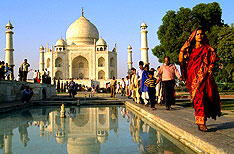 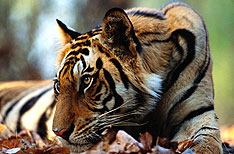 About Uttar Pradesh Uttar Pradesh is a land of cultural and geographical diversity, blessed by a innumerable tranquil expanses of meadows, perennial rivers, dense forests, fertile soil, plays a very important role in the politics, education, culture, industry, agriculture and Tourism of India. A place of gods and goddesses, a land which has a glorious history. It is the land of Rama, Krishna, Buddha, Mahavir, Ashoka, Harsha, Akbar and Mahatma Gandhi. It is a land dotted with countless shrines and pilgrimage which hold a special significance in the lives of the Indian people. Guarded by the majestic Himalayas in the north, garlanded by Ganga and Yamuna. Surrounded by states like Bihar, Madhya Pradesh, Rajasthan, Delhi, Himachal and Haryana. It has a strategic importance for Indian Defense as it touches Tibet and Nepal on the Northern Border of the country. Situated in the northern part of India, it has the distinction of being the most populous state of India. in terms of area, it is the fourth largest, among all the states. The wealth of its monuments, mystical call of its mountains and lakes, and the religious fervour that it evokes, have rendered Uttar Pradesh, one of the most fascinating states of the Indian Union. Whether one is on a spiritual quest, or in search of adventure, or just on a curiosity trip, Uttar Pradesh has something to offer to everyone. It is divisible into three distinct regions geographically; the Himalayan region on the north, the vast Gangetic plain at the centre, and the Vindhya Range and plateau on the south. Uttar Pradesh is watered by the mighty rivers of northern India - Ganga, Yamuna, Ramganga, Gomati and Ghaghara. Almost all the important towns and trading centres of the state, are clustered around these rivers. The confluence of the Ganga and Yamuna, the two most sacred rivers of India, at Allahabad, has been a vital pilgrimage site through the centuries. Uttar Pradesh offers an endless array of attractions, to the tourist by way of monuments, health resorts, mountain peaks, a wealth of ancient temples and viharas, rich flora and fauna, fascinating rivers and captivating valleys. Agra, Ayodhya, Sarnath, Varanasi, Lucknow, Mathura and Prayag combine religious and architectural marvels; Nainital, Mussorie, Ranikhet and Almora are hill resorts of rare charm; Corbett and Dudhwa National Parks head a long list of wildlife reserves and sanctuaries; Yamnotri, Gangotri, Kedarnath, Badrinath, Hemkund and the Pindari Glacier, enfolded wthin the Himalayan ranges, offer a combination of adventure, pilgrim centres and natural beauty. HISTORYOver 2000 years ago the area that became Uttar Pradesh was part of Ashoka's great Buddhist empire. Muslim raids from the north-west began in the 11th century, and by the 16th century the region was part of the famed Mughal empire whose capital was for some time at Agra and Fatehpur Sikri. Following the decline of the Mughal empire, the nawabs of Avadh rose to prominence in the central part of the region and were responsible for turning Lucknow into a flourishing center for the arts. When the British East India Company deposed the last nawab, the Uprising of 1857 began at Meerut, and its most tragic events took place in Lucknow and Kanpur. Agra was later merged with Avadh and the state became known as United Provinence. It was renamed Uttar Pradesh (Northern State) after Independence, and is often known simply as U.P. CULTUREBlessed with a variety of geographical land and many cultural diversities, Uttar Pradesh, has been the area of activity of historical heroes like Rama, Krishna, Buddha, Mahavira, Ashoka, Harsha, Akbar and Mahatma Gandhi. Dotted with various holy shrines, pilgrim centres, historical monuments and full of joyous festivals, its contributions to India in politics, culture, and society are outstanding. The findings of the archaeological excavations in Banda, Mirzapur and Meerut, and the chalk drawings by primitive men extensively found in the Vindhyan ranges of Mirzapur districts, link Uttar Pradesh to the early Stone Age and Harappan era making it one of the ancient cradles of Indian culture. FAIRS AND FESTIVALSJhansi Festival - MarchThis week-long annual event is a display of the arts, crafts and culture of the splendid city Jhansi. The cultural programmes include folk songs, dances and mushairas. Lucknow Festival - NovemberThis festival celebrates Lucknow's living culture. Capital alight during this ten day long event. Colorful processions, traditional dramas Kathak dances in the style of the famous Lucknow gharana, sarangi and sitar recitals along with ghazals, qawalis and thumri create a festive atmosphere. Exciting events like ekka races, kite flying, cock fighting and other traditional village games recreate an atmosphere of Avadh's nawabi days. Jhoola FairThe fortnight long Jhoola fair of Mathura and Vrindavan and Ayodhya, when dolls are placed in the gold or silver jhoolas or cradles is worth witnessing. Magh MelaThis Mela is celebrated every winter in January. People come and settle there for a month to have a dip in the holy Sangam every morning. Bateshwar Cattle FairA famous cattle fair is held at Bateshwar in Agra district. Holi Duringspring, the festival of colours is celebrated all over India. Holi is a time to make merry. People smear each other with coloured powdered. Singing and dancing add to the gaiety of the occasion. The holi celebrations in Mathura - the land of Sri Krishna are spectacular. The Rang Gulal Festival is celebrated for a week with exuberant processions, songs and music. Especially famous is the 'Lathmar Holi' of Barsana and Nandgaon. JanmashtamiThe birth of Lord Krishna is celebrated with great fervour all over the country. In Mathura and Vrindavan - where Lord Krishna spent his childhood and youth, the Janmashtami celebrations are quite elaborate. The Krishna Leela stories of his eventful youth are enacted. In Maharashtra, earthen pots of curd and butter are hung up over the streets. Young men enacting an episode from Krishna's childhood form human pyramids by climbing on each other's shoulders and try to break these up. Kumbh MelaThe biggest congregation, perhaps of the entire world, Kumbh Mela is held at Allahabad every twelfth year. Ardh Kumbha Mela is also held at these places every sixth years. FOLK ARTSBraj RaslilaRaslila is a theatrical form prevailing in Agra Region that is known as Braj area. This art form is associated with the life of Lord Krishna who is an incarnation of Lord Vishnu. According to the Bhagwat Purana, Shri Krishna along with the gopis had danced the Ras on the banks of the Yamuna at Vrindavan. In the midst of the dance he disappeared agonising the Gopis who enacted his lilas, which in course of time came to be known as the Raslilas. This colourful and glossy art form emphasises on music and dancing. The story generally deals with the relationship of Lord Krishna with his consort Radha and his charming childhood pranks. The Centre of this art form is Mathura. RamlilaRamlila is performed during Dussehra that commemorates the victory of goodness represented by Rama over Ravan representing forces of evil. With the passage of time local variations of Ramlila have sprung up in different parts of the State with changes in dialogue and music. This art form is performed almost in all villages during the Dussehra festival. Ramlila is a traditional art form that deals with the life of Lord Rama who is another incarnation of Lord Vishnu. Ramlila, basically an enactment of a myth, is presented as a cycle-play with the story varying from 7 to 31 days. The Ramlila performance evokes a festive atmosphere and enables observance of religious rites. It is also rich in performance crafts such as costume jewellery, masks, headgear, make-up and decoration. CharkulaCharkula is a traditional folk dance of Braj, where a female dancer balances a column of lighted deepikas over her head while dancing. The charkula, a tapered wooden column with four to five circular tiers has earthen lamps on each level. The number of lamps may range from 51 to 108 at times. The dancer, balancing the charkula on her head, moves with swift and graceful movements to the tune of Rasiya songs. The dance is performed on the Dooj of Holi. RasiyaThis is the rich tradition of folksongs that is found in the Braj area. Rasiya songs describe the love of the divine couple Radha and Shri Krishna. It is an inseparable part of the Holi celebrations and all other festive occasions at Braj. The Rasiya is sung to the rhythm of huge drums, locally known as bumb. ARTS AND CRAFTSChikankari Embroidery WorksChikankari is the delicate and traditional embroidery practiced in Lucknow and it?s environs. Chikan is a unique craft involving delicate and artistic hand embroidery on a variety of textile fabric like muslin, silk, chiffon, organza, doriya and organdi. There are 36 types of stitches used in chikan work. Chikan's light and gossamer like quality makes it very suitable for the hot climate. The light chikan saris and chikan kurtas are perfect summer wear. The finely embroidered muslin came to be closely identified with the Nawabi culture and became an intrinsic part of it. The Chikankari tradition gradually spread among the common people. The source of most design motifs in Chikankari is Mughal. Though it originated as a court craft, today it is a practiced tradition and an important commercial activity. Zardoji Embroidery WorksAgra's Zardoji is very unique art of embroidery in three dimensions. The artist first makes free hand sketches of these subjects. Then he embroiders in cotton threads over and over till he gets the required thickness and movements. Finally the artist takes fibre from silk threads, twists then together in the shades required for and embroiders with them the particular piece. In the process he creates original unparallel work of art. Zari WorksThe zari thread known as 'kalabuttum', consists of finely drawn gold, silver or base metal threads wound round as silk thread. The deep red, golden zari saris are popular with almost all Indian brides. Kimkhabs, one of the best-known Varanasi brocades, have more zari work visible than silk. The design motifs of these brocades are intricate floral and foliage patterns. The brocades are woven in workshops known as 'karkhanas'. The weavers are mainly Muslim and are known as 'karigars' that means 'artist'. Banaras is world famous for hand-made textiles. The ancient traditions of weaving is well preserved in Banaras. The main products are Zari and brocades. Metal WareUttar Pradesh is the largest Brass and Copper producing state in India. In domestic-ware each of the 'lotas' (small water-pots) is known by the name of its origin, like Etawah, Banaras, Sitapur, etc. The ritual articles are largely in copper. Moradabad in U P is famous for art metalwork and known for it's coloured enamelling and intricate engravings. The art was handed down from the Mughal Era. They still continue to dominate the Indian market for engraved as well as utilitarian brass. Plates, cups, bowls, boxes and coffee pots are engraved with a range of floral and geometric patterns and these compositions are often inlaid with brightly coloured Lac or vegetable resin. The decorations may include scenes reminiscent of the style of Mughal painted miniatures, but also portray incidents from the Hindu Scriptures. PotteryGorakhpur in Uttar Pradesh, has villages where clay figures of animals are done and is is famous for its ornately decorated terracotta horse. The potter creates the basic form by throwing separate pieces on the wheel and then joining them. Glazed pottery with white background and blue and green patterns is developed in Khurja, Chunar and Rampur in Uttar Pradesh. UP produces some of the finest Chunar black clay pottery. This is inlaid with silver paint in intricate designs. The art that is perfected in Nizamabad, has high gloss and lustre derived from a powder called kabiz made from the mud of rice fields. Khurja is also well known for its cheap and tough tableware. Carpets and Floor CoveringsCarpet weaving is one of the crafts in Uttar Pradesh. UP produces about 90 % of the country's carpets in and around Mirzapur, Bhadohi and Khamaria. These carpets are popular export items today. Agra in Uttar Pradesh is one of the old carpet centres of the Mughal days. It produces both the traditional as well as the new designs. In Shahjahapur, both cotton and woollen carpets are made. The designs are of the Old Persian style. JewelleryLucknow is well known for its jewellery and enamelling work. Exquisite silverware's with patterns of hunting scenes, snakes and roses are very popular. The Bidri and Zarbuland silver works of Lucknow find expression on excellent pieces of huqqa farshi, jewel boxes, trays, bowls, cufflinks, cigarette holders, etc. Renowned ivory and bone carvings with motifs of flowers, leaves, creepers, trees, birds and animals are widely produced in Lucknow. The master craftsmen create intricate items like knives, lampshades, shirt pins and small toys. Perfume'Attars' or perfumes are also produced in Lucknow from the 19th century. The Lucknow perfumers experimented and succeeded in making attar with delicate and lasting fragrances those are made from various aromatic herbs, spices, sandal oil, musk, essence of flowers, and leaves. The famous Lucknow fragrances are khus, keora, chameli, zafran and agar. MUSICMadhya Desh was the land of the great sages and hermits and the singing of ancient hymns and mantras laid the basic tradition of music, which has blossomed into a musical tradition. The ages of Guptas and Harsh Vardhan were the peaks of music in Uttar Pradesh in the past. The medieval age saw the emergence of two distinct strands of music. One was the court music that found patronage in the Courts like Agra, Fatehpur-Sikri, Lucknow, Jaunpur, Varanasi, Ayodhya, Banda and Datiya. The second was the religious tradition emerging from the Bhakti Cult rooted and flowered in centres like Mathura, Vrindavan and Ayodhya. Rulers and musicians from Uttar Pradesh contributed to the prosperity of Hindustani music. WILDLIFE SANCTUARIES- Chandra Prabha Sanctuary MUSEUMS IN UTTAR PRADESHBharat Kala Bhavan - VaransiBharat Kala Bhavan lies within the sprawling grounds of Banaras Hindu University. Its outstanding collection of sculpture, painting and textiles began with the private collection of the enlightened Rai Krishnadasa. The sculpture collection includes terracotta and clay objects. Ancient terracotta varing from ritual icons to toys to utilitarian objects date to the Indus Valley Civilisation, Mauryan, Sunga and Gupta periods. Among the stone sculptures are red sandstone reliefs from the 2nd century B.C, Buddhist stupa at Bharhut and rare image and statues from well known schools like Gandhara, which saw the synthesis of Greek and Indian styles and Mathura, a powerful art centre during the Kushana period. The large and impressive collection of textiles contain precious example of Banaras silk and brocades, embroidered shawls from Kashmir and the rare Chamba rumals, once used to wrap ceremonial gifts and offering were richly embroidered pieces with designs and stories from the life of Krishna. State Museum - LucknowA multipurpose museum with sculptures, bronzes, paintings, natural history and anthropological specimens, coins, textiles and decorative arts. Rare stone sculptures include the earliest image of Balarama and a panchmukhi shivalinga (both 2nd century B.C), and a statue of Saraswati, again reputed to be the earliest depiction (2nd century A.D). Archaeological Museum - SarnathSarnath, where the Buddha delivered his first sermon more than 2500 years ago, has a site museum whose prize exhibit is the enormous lion capitals(2.31m). Now the emblem of Independence India, the capital once surmounted an Ashokan pillar erected to mark the spotwhere the Budhha preached There are many other Buddha and budhisattava figures on view. Among these the most outstanding Gupta periods with hand rised on Abhaya or protection. Government Museum - MathuraThe rich treasure of antiquarian values unearthed by Cunnigham, Growse, Fuhrer and others formed the nucleus of this museum. The museum was founded by the collector, F.S. Growse in 1874. The collections were shifted to the present building in 1930. Regional in character its scope was limited primarily to the archeological finds from the Mathura region. The vast collection includes stone sculptures, bas reliefs, architectural fragments, inscriptions of various faiths and creeds, coins, terracotta, inscribed bricks, pottery pieces, clay seals, bronze objects and paintings. The museum has the richest and by far the most important collection of the Mathura School of Sculptures of 3rd century B.C - 12th century A.D. General Information of uttar Pradesh LOCATIONUttar Pradesh lies between latitude 24?-31?N and longitude 77?-84?E. Area wise, it is the fourth largest state of India. In sheer magnitude, it is half of the area of France, three times of Portugal, four times of Ireland, seven times of Switzerland, ten times of Belgium and a little bigger than England. How to Reach By AirThere are four domestic airports in Uttar Pradesh, i.e., in Agra, Kanpur, Lucknow, and Varanasi. However, there is no international airport. Major cities in Uttar Pradesh are connected by air to Delhi and other large cities of India. By RailThe state is connected with the major cities of India by trains. Lucknow, Kanpur, Allahabad and Mughalsarai are some of the major railheads that are linked to the rest of the country by express, super-fast and passenger trains. By RoadUttar Pradesh is connected to the rest of the country by a good network of roads. Some of the important national highways that connect that state are NH 2, 25, 26, 27, 29, and 45. BEST TIME TO VISIT The entire state, except for the northern region, has a tropical monsoon climate. In the plains, January temperatures range from 12.5?C-17.5?C and May records 27.5?-32.5?C, with a maximum of 45?C. Rainfall varies from 1,000-2,000 mm in the east to 600-1,000 mm in the west. Tourist Attractions in Uttar Pradesh Agra
Agra is famous for handicrafts products such as Inley work on Marvel, Leather work, Footwear, Brasswear, Carpets, Jwellery, Zari and Embroidery work. It is also well known for Petha, Dalmoth and Gajak. Chitrakoot Chitrakoot,"the hills of many wonders" is indeed a gift of nature and the gods. Located in the Banda district of modern Uttar Pradesh(U.P), on the banks of river Paisuni(Mandikini),Chitrakoot is a tranquil retreat on the northern spur of the Vindhyas. Just 6 km south of Karvi and 72 km south east of Banda district on the road to Allahabad, Chitrakoot Dham is one of the most ancient holy pilgrim places of India. Legends have it that it was the abode of Lord Rama, his wife Sita and brother Lakshman for eleven years of their fourteen years of exile. This is also the place,where they came in contact with sage Atri and sati Anasuya.This abode of the gods is credited to have seen the incarnations of Brahma,Vishnu and Mahesh. Bithoor The quiet and beautiful township of Bithoor is situated on the Kannauj Road, 27 km from Kanpur. Situated on the banks of the Ganga, this tranquil spot is of considerable historical and religious importance. According to Hindu scriptures Lord Brahma came to Utpalaranya, as it was known then, for the creation of mankind. The place which first witnessed the creation of mankind came to be known as Brahmavarta or the seat of Brahma. Later Brahma installed a Shivalinga which is still worshipped as Brahmeshwar Mahadeva at the principal Ghat of Bithoor, The Brahmavarta Ghat. A nail of the horse shoe which is embedded in the steps of the Ghat is an object of special reverence for devotees, considered to be of Brahma?s horse, while going for Ashwamedha Yajna. On the completion of the Yajna, the forests of Utpalaranya, became known as Brahmavarta, from which the popular name, Bithoor is derived. In later centuries Brahmavarta flourished as the capital of the kingdom of Utpalaranya, over which ruled the emperor Uttanpad. His son Dhruva penanced here in order to please Brahma. The place is pointed out to be Dhruva Teela. Lucknow
Chaukori Chaukori is imbued with the breathtaking beauty of Pithoragarh district. It offers a magnificent view of the Panchchuli peaks and has few rivals for spectacular Himalayan sunrises and sunsets. Visitors to this lesser-known part of Kumaon can enjoy nature at her pristine best. Forests of pine, oak and rhododendron are interspersed with cornfields and orchards. The climate is conducive to the growth of tea, which is cultivated by some enterprising locals. Chaukori holds the promise of an idyllic vacation, and a close communication with nature. Ayodhya Ayodhya is preeminently a city of temples yet, all places of worship here, are not only of Hindu religion. At Ayodhya several religions have grown and prospered simultaneously and also at different periods of time in the past. Varanasi
Dakpathar Located at the foothills of Shivalik, on the banks of river Yamuna, Dakpathar is the newly developed recreation center of GMVN. It is a tourist complex with spacious lawns & gardens with a full standard size swimming pool, where facilities for coaching are available. Dhanaulti Dhanaulti located amidst thick, virgin forests of deodar, rhododendron and oak has an atmosphere of perfect peace & tranquility. The long wooded slopes, lazy outings, cool caressing breeze, warm and hospitable inhabitants, lovely weather and fabulous view of snow covered mountains makes it an ideal retreat for a relaxed holiday. Situated on the Mussoorie - Charfiba route, Dhanaulti is 25 km. from Mussoorie. Allahabad
Deogarh Deogarh is situated on the right bank of the Betwa river at the western end of the Lalitpur range of hills. Due to its strategic location(being on the main route to Deccan), it was a bone of contention and figures in the history down the ages. Not surprisingly, it is of great antiquarian, archeological and epigraphical importance and finds mentions in the history of the Guptas, the Gurjara-Pratiharas, the Gonds, the Muslim rulers of Delhi as well as the Marathas and the British. With a dramatic natural setting,the Deogarh fort is entered through a corbelled gateway in the outerwall. During the 8th to 17th centuries,it was a Jain center and still houses 31 Jain temples. Panels depicting scenes from Jain Mythology,votive pillars, votive tablets and Jain images are visible from all sides. Deshavatar temple,dedicated to Lord Vishnu, lying close to the banks of the Betwa is the Jewel of Deogarh. harsil Situated amidst the incredible beauty of mountain peaks, 5000 mts. high is the quiet resort of Harsil. Where flowers bloom as an expression of joy. Where walks, picnics and treks lead one to undiscovered stretches of green, grassy land... serving as a perfect invitation to sit down, relax and enjoy the surroundings. A perfect tribute to nature. Mathura
Dudhwa The Dudhwa National Park, which is also a Tiger Reserve, is located in the district of Lakhimpur -Kheri, very close to the Nepal border. The 498.29 sq. km. Park has fine sal forests and extensive grasslands. Tall coarse grass sometimes forming impenetrable thickets, swampy depressions and lakes characterise the wetlands of the Park. These are the habitat of large numbers of barasingha, the magnificent swamp deer, noted for their multi-tined antlers (bara-12, singha-horn). These in turn support the predators - the tiger and leopard. Though the Park has a fair population of tigers, they are rarely seen owing to the nature of the forest cover. Jhansi Lying at a distance of 292 Kms from Lucknow and about 415 Kms from Delhi. Jhansi is the gateway to Bundelkhand. The city is more popularly linked with the heroics of Rani Laxmi Bai, the fiery queen who fought against the Britishers in the 1857 revolt. Located on a rocky hill, the Jhansi fort was built originally in 1613 by Raja Bir Singh Ja Deo and has a marvelous collection of sculptures reflecting a excellent insight into the grand history of Bundelkhand. A fine collection of sculptures belonging to the period between 9th and 12th centuries A.D. has been housed in the Rani Mahal. Vrindavan
Nandgaon Nandgaon lies 8.5 km north of Barsana on the metalled road to Mathura (56 km). According to tradition, it was the home of Shri Krishna`s foster father, Nand. On the top of the hill is the spacious temple of Nand Rai, built by the Hat ruler Roop Singh. The other temples here are dedicated to Narsingha, Gopinath, Nritya Gopal, Girdhari, Nand Nandan, and Yasodha Nandan, which is located half way up the hill. A little beyond is the Pan Sarovar, a large lake with masonry ghats along its sides. Legend has it , that this was the place where Shri Krishna used to take his cows for water. Not far away is the Kadamb grove called Udhoji- ka - Kyar. The spacious temple to Nand Rai built by the Jat Ruler Roop Singh is located on a hill. Gokul The most celebrated of Shri Krishna's abodes, Gokul lies to the west of Sadabad, 1.6 km from Mahavan and 15 km south-east of Mathura, on the Mathura -etah metalled road. It was here that Lord Krishna was brought up in secrecy by Yashoda, in the pastoral beauty of this village on the banks of the Yamuna. Gokul attained importance during the time of vallabhacharya (1479-1531) when it became a major cente of the Bhakti cult. The three oldest temples in the place are those dedicated to Gokulnath, Madan Mohan and Vithalnath, said to have been built around 1511. kanpur
Sarnath Sarnath, about 10 kms from the holy city of Varanasi, is the blessed locale where more than 2,500 years ago Buddha chose to deliver his first sermon, after attaining Nirvana. The five disciples who had followed him were surprised to see the mesmerizing glowing countenance of Buddha, who convinced them and delivered his first sermon before them, now termed Dharamachakra Pravartan. This set in motion the great Buddhist tradition of the Sangha, for popularizing the teachings of the great ascetic, worldwide. Gautam Buddha with his five disciples formed the first Sangha alongwith Yasa of Varanasi and his 54 friends. The beginning of the celebrated Mantra, 'Buddham Sharanam Gachhami', owes its origin to Sarnath. The three Jewels "I go for refuge to the Buddha, I go for refuge to the Wheel of Law, I go for refuge to the Sangha" first laid down here, have remained unchanged ever since. Hence rightly, every Buddhist Pilgrim after Bodhgaya, endeavors to be blessed with a visit to Sarnath in his life time. |
 Agra is situated in the State of Uttar Pradesh, India. It is one of the prominent destinations of the World Tourism map with three heritage monuments-The Taj Mahal, Red Fort & Fatehpur Sikri. It is more just a dacadent city of graveyards and stones, but it is a vibrant centre of Culture, Art and Religious philosphies that have enriched mankind and shaped humen thought over centuries.
Agra is situated in the State of Uttar Pradesh, India. It is one of the prominent destinations of the World Tourism map with three heritage monuments-The Taj Mahal, Red Fort & Fatehpur Sikri. It is more just a dacadent city of graveyards and stones, but it is a vibrant centre of Culture, Art and Religious philosphies that have enriched mankind and shaped humen thought over centuries.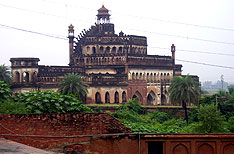 The capital of Uttar Pradesh, Lucknow is a city synonymous with the Nawabi Culture. Lying on the banks of river Gomati, a tributary of the Ganga, the city is most talked about its imperialistic splendors and magnificence of the Nawabi Era. The city, known for its Adad and Tehzeeb (Cultural refinement) rose to prominence during the Indo - Islamic (Medieval period). especially the Mughals and later under the Nawabs of Awadh and thence, subsequently under the British. Noted for its fine bidri (silver - inlaid black metalware) jewelry. Chikan work (Cotton embroidery), toys, renowned cuisine, cultural heritage and traditions, the city once rivaled even Delhi in its patronage to art and literature. The city is also credited with the development of new musical forms and instruments under the royalty. Singing styles of Dadra, Thumri, Khayal, Qawqalis, Ghazals and the dance form Kathak saw their finest hours in this historic city.
The capital of Uttar Pradesh, Lucknow is a city synonymous with the Nawabi Culture. Lying on the banks of river Gomati, a tributary of the Ganga, the city is most talked about its imperialistic splendors and magnificence of the Nawabi Era. The city, known for its Adad and Tehzeeb (Cultural refinement) rose to prominence during the Indo - Islamic (Medieval period). especially the Mughals and later under the Nawabs of Awadh and thence, subsequently under the British. Noted for its fine bidri (silver - inlaid black metalware) jewelry. Chikan work (Cotton embroidery), toys, renowned cuisine, cultural heritage and traditions, the city once rivaled even Delhi in its patronage to art and literature. The city is also credited with the development of new musical forms and instruments under the royalty. Singing styles of Dadra, Thumri, Khayal, Qawqalis, Ghazals and the dance form Kathak saw their finest hours in this historic city. 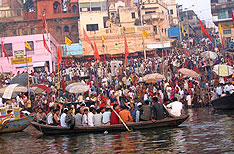 Varanasi is one of the oldest living cities in the world. Many names have been given to Varanasi, though its recently revived official appellation is mentioned in the Mahabharata and in the Jataka tales of Buddhism. It probably derives from the two rivers that flank the city, the Varana to the north and the Asi to the south.. Many still use the anglicized forms of Banaras or Benares, while pilgrims refer to Kash, first used three thousand years ago to describe the kingdom and the city outside which the Buddha preached his first sermon; the "City of Light" is also called Kashika, "the shining one", referring to the light of Shiva. Another epithet, Avimukta, meaning "Never Forsaken", refers to the city that Shiva never deserted, or that one should never leave. Further alternatives include Anandavana, the "forest of bliss", and Rudravasa, the place where Shiva (Rudra) resides.
Varanasi is one of the oldest living cities in the world. Many names have been given to Varanasi, though its recently revived official appellation is mentioned in the Mahabharata and in the Jataka tales of Buddhism. It probably derives from the two rivers that flank the city, the Varana to the north and the Asi to the south.. Many still use the anglicized forms of Banaras or Benares, while pilgrims refer to Kash, first used three thousand years ago to describe the kingdom and the city outside which the Buddha preached his first sermon; the "City of Light" is also called Kashika, "the shining one", referring to the light of Shiva. Another epithet, Avimukta, meaning "Never Forsaken", refers to the city that Shiva never deserted, or that one should never leave. Further alternatives include Anandavana, the "forest of bliss", and Rudravasa, the place where Shiva (Rudra) resides.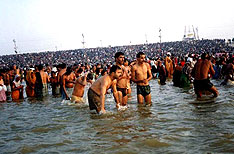 The modern city of Allahabad is noted for having links with or having produced presidents and premiers, both at the national as well as state levels. From the first prime minister of India - Pt. Nehru to Lal Bahadur Shastri, Indira Gandhi, Rajiv Gandhi, V.P. Singh and Chandra Shekhar to Dr. Shankar Dayal Sharma(ex - President) and a plethora of bureaucrats and people who have been adorning gubernatorial positions, Allahabad has remained on the forefront of national importance. Allahabad is the land of the holy sangam where religion, history and culture come together. Legends have it that the Creator god of the trinity, Lord Brahma chose this land for the 'Prakishta Yagna',on which the three rivers - Ganga,Yamuna and the mythical Saraswati- would flow in a quiet confluence. Blessed by the gods, that land came to be known as 'Prayag' or 'Allahabad'.
The modern city of Allahabad is noted for having links with or having produced presidents and premiers, both at the national as well as state levels. From the first prime minister of India - Pt. Nehru to Lal Bahadur Shastri, Indira Gandhi, Rajiv Gandhi, V.P. Singh and Chandra Shekhar to Dr. Shankar Dayal Sharma(ex - President) and a plethora of bureaucrats and people who have been adorning gubernatorial positions, Allahabad has remained on the forefront of national importance. Allahabad is the land of the holy sangam where religion, history and culture come together. Legends have it that the Creator god of the trinity, Lord Brahma chose this land for the 'Prakishta Yagna',on which the three rivers - Ganga,Yamuna and the mythical Saraswati- would flow in a quiet confluence. Blessed by the gods, that land came to be known as 'Prayag' or 'Allahabad'.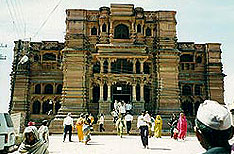 The land where Lord Krishna was born and spent his youth, has today little towns and hamlets that are still alive with the Krishna- legend and still redolent with the music of his flute. Mathura, a quiet town on the River Yamuna was transformed into a place of faith after Lord Krishna was born here. Vrindavan, a village - once noted for its fragrant groves, is where he spent an eventful youth. There are numerous other little spots in the area that still reverberate with the enchantment of Lord Krishna.
The land where Lord Krishna was born and spent his youth, has today little towns and hamlets that are still alive with the Krishna- legend and still redolent with the music of his flute. Mathura, a quiet town on the River Yamuna was transformed into a place of faith after Lord Krishna was born here. Vrindavan, a village - once noted for its fragrant groves, is where he spent an eventful youth. There are numerous other little spots in the area that still reverberate with the enchantment of Lord Krishna.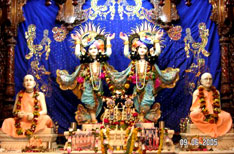 Vrindavan 15 Km. north of Mathura on the same bank of Yamuna, lies the celebrated town of Vrindavan, almost as closely associated with Krishna as Mathura itself. Indeed one hardly speak of Vrindavan alone to; the devout Hindu. Mathura-Vrindavan can not a unified image of untold beauty and religious sanctify.
Vrindavan 15 Km. north of Mathura on the same bank of Yamuna, lies the celebrated town of Vrindavan, almost as closely associated with Krishna as Mathura itself. Indeed one hardly speak of Vrindavan alone to; the devout Hindu. Mathura-Vrindavan can not a unified image of untold beauty and religious sanctify.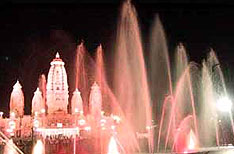 Kanpur, is the main industrial center of Uttar Pradesh. Situated on the banks of the eternal Ganga has its own historical, religious and commercial importance. Hindu Singh of the erstwhile estate of Sachendi is believed to be the founder of Kanpur, which was originally called 'Kanhpur'. Jajman on the eastern outskirts of present day Kanpur is regarded as one of the most archaic township of the district. Famous for its leather and textile goods. It has amongst its historical remains the memorial Church where 'All souls cathedral' was raised in honor of the fallen at the 'Wheeler's entrenchment' in 1962. After 1947, the marble Gothic screen was transferred to the Church yard.
Kanpur, is the main industrial center of Uttar Pradesh. Situated on the banks of the eternal Ganga has its own historical, religious and commercial importance. Hindu Singh of the erstwhile estate of Sachendi is believed to be the founder of Kanpur, which was originally called 'Kanhpur'. Jajman on the eastern outskirts of present day Kanpur is regarded as one of the most archaic township of the district. Famous for its leather and textile goods. It has amongst its historical remains the memorial Church where 'All souls cathedral' was raised in honor of the fallen at the 'Wheeler's entrenchment' in 1962. After 1947, the marble Gothic screen was transferred to the Church yard.